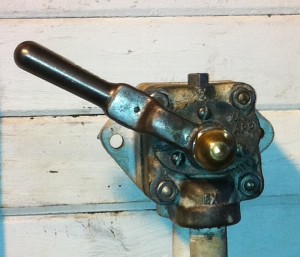Restoring the brake valve and air pressure gauge in the TH&B Caboose – Part 2 of 2
Bill Kaufman developed our U33C Simulator (in his back yard in a garage over 19 years) and has graciously helped us further develop and maintain it despite living in upstate New York. Bill is also a federally licensed engineer who volunteers on the Adirondack Scenic Railway so is well versed in train operations. I asked him about the use of brake valves in cabooses and he offered this information:
“This is the Conductor’s Backup Brake Valve. Rules require someone be the “eyes” on any reverse move of the train. If it is more than just switching, they must also have the ability to control the brakes. The valve Michael describes would be used for that purpose. The different Application holes would give the operator the ability to apply the brake at different rates. The engineer must also apply the brakes in the engine when he sees the Brake Pipe pressure dropping on the gauge. If he does not, the engine will continue to try to recharge the brake pipe and thus slow down the ability of the rear operator the ability to set the brakes.
The LAP position closes the brake pipe so it will no longer vent the brake pipe to the atmosphere. I am not sure what the last position is for. I wonder if there is a separate Whistle button or valve on the caboose. If not I wonder if this port is plumbed into a pipe connected to the air whistle on the caboose. The rear end operator must also have the ability to blow his whistle for warning purposes.
Today we do not use such advanced valves. We use just a regular a Open / Close ball valve and regulate the rate by how much we open the valve. In most cases this valve is attached to the end of a long hose that snakes down to the brake pipe hose. We call the assembly the Backup Hose. Our former CN/VIA passenger cars (on the Adirondack Scenic Railway) have valves built into the walls at the ends of the cars but we do not use them. I am not even sure they are connected anymore. They also have a separate whistle valve connected to an air whistle located on the end sheet of the car.”
Click here to read part 1 of this posting.
Posting by Russ Milland; Photo by Michael Guy
Click on the image for a closer look!


